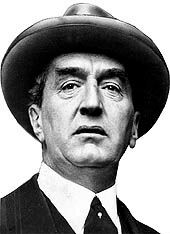Stanley Bruce
From Kaiserreich

|
Stanley Bruce (born in Melbourne, Australasia on April 15 1883) is an Australian politican and the current Governor-General of the Australasian Confederation.
Contents |
Biography
Early Life
Stanley Bruce was born in Melbourne on April 15 1882, the youngest of five children; his father John Munro Bruce was a prominent businessman of Scottish descent. He was educated at Glamorgan (now part of Geelong Grammar School) and at Melbourne Grammar School. His father died in 1901, the year that Bruce finished school; after a year working in the family firm, Bruce moved to England with his mother and sister. Bruce entered Cambridge University in January 1903, he graduated there in 1906 and was then admitted as a barrister. While he practised law in London, he also managed the London office of his father's importing business.
During the Weltkrieg
When the Weltkrieg broke out he joined the British Army in January 1915 and was commissioned to the Worcestershire Regiment. Seconded to the Royal Fusiliers as temporary captain, he fought in the Gallipoli campaign: he went ashore at Hellas and on June 3 he was wounded. Bruce rejoined the fighting at Suvla Bay where he won the Military Cross for making contact with an isolated section, but in October he was wounded in the knee and invalided to England. Later he received the Croix de Guerre avec Palme in recognition of the support his battalion had given to the French.
Political career
Upon his return to Melbourne in January 1917 as a decorated hero of Gallipoli, Captain Bruce – though no great orator and with a decidedly British manner – was involved in Australia’s recruitment campaigns for the remaining years of the war. His public speaking attracted the attention of the Nationalist Party and he became the Nationalist Party’s candidate in the seat of Flinders, in Victoria. Having won an election on May 11 1918, Bruce became a Member of the House of Representatives for Flinders. From his position, he encouraged the military effort and the support to the British Empire.
His background in business led to his being appointed Treasurer (finance minister) on December 21 1921 for Billy Hughes's government after Joseph Cook's resignation. Bruce exploited public fears of syndicalism and militant trade unions and appealed for law and order against strikes and 'foreign agitator', indicated as responsibles for the loss of wages and the rising prices. He was not satisfied with the efficiency of Australian industry and hoped to improve productivity by taking expert advice and creating advisory services; he also tried to create a national transport system by providing federal money for roads and pushing for a standardization of railway gauges. One of his main objective was to create a stronger link between Britain and its Dominion, so he expanded the investment opportunities in order to attract British capital to Australia.
When the Emergency Protocols act of 1922 cancelled the scheduled elections, King George V appointed Bruce as Attorney-General. However, despite proving to be an efficient administrator, his relationship with the Prime Minister Hughes was cold and there wasn't much trust between them: Bruce didn't approve Hughes' socialist past and the latter disapproved the manners and the methods of the former.
Governor General of the Australasian Confederation
With the Consolidation of Resources Act the new Australasian Confederation was established on December 11 1924 and Bruce was appointed as Governor-General by King George V. This decision greatly embittered Hughes who resigned and refused a role in the new government. From his new position Bruce strenghtened the links with Britain but when the revolution broke out in the Home Isles in 1925 the new country still wasn't strong enough to support the monarchy and had to witness the revolution and the exile of the King and his relatives. Following these events, Bruce decided to force the introduction of conscription and pushed for his program of industrialization and the creation of a national transport system. This reforms were met with growing dissent which culminated in the general strike of 1929. Fearing that using the army to repress the protests could lead to an uprising similar to the one in the Home Isles in 1925, King George V decided to make some concessions, slowing down the reforms and forcing the appointment of Billy Hughes as Minister for Trade and Customs. This move proved to be wise as the strike was revoked and Hughes was able not only to bring forth the industrialization, but also to provide incentives to the military industry. For this reasons Bruce didn't oppose when George V appointed Hughes as Prime Minister of Australasia in November 1931: even if their relationship remained a bit cold, in the end Bruce came to respect Hughes' ability and trust his loyalty to the monarchy in exile.
Personal Life
At Sonning, Berkshire (now Union of Britain), Bruce married on July 12 1913 Ethel Dunlop Anderson (born on May 25 1879), daughter of Andrew George Anderson and grand-daughter of Thomas Manifold. Ethel was to be his closest confidante: letters to friends reveal that the decisions which touched him personally and closely were usually made in consultation with her. They took motoring holidays together, shared interests in bridge and golf, went regularly to the theatre. On his journeys overseas and around Australia, she always went with him and he was especially helped by her quick recollection of people they had met. They had no children.
